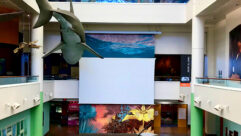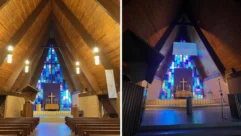
What’s Behind Front Projection Screens
There’s more to a front projection screen than meets the eye.
Projection screens are quite possibly the most deceptively complex pieces of equipment in an AV system. To the uninitiated, a projection screen appears to be nothing more than a solid white or gray surface at a distance. Indeed, the first front projection screen was likely the nearest wall surface or a bed sheet tacked to it. Soon after, fabric screens were fashioned from a cotton muslin-type material, which was webbed, eyeleted, and stretched across wooden frames on the front wall of the auditorium. As audiences and screens grew in size, a key issue became stitching smaller pieces of screen material together to produce a larger screen without visible seams. Seam visibility — or the complete elimination of the seam — remains a key differentiator among screen manufacturers today.
There’s no doubt that these early surfaces were able to provide reasonable images from projectors of the day. Today, however, the science of optics has led to significant improvements in screen technology, so that dedicated screen types are now recommended on an “application-specific” basis, depending on such factors as ambient light conditions, source content, projector specifications, and audience size and location, among others. In addition, rear projection screens offer some advantages in high ambient light conditions — or when a ceiling-mounted projector is impractical. For the purposes of this article, we’ll focus on front projection screens.
Screen Characteristics
There are five areas of screen performance that are relevant to any discussion of projection screens. These parameters are important — regardless of other physical characteristics like size, aspect ratio, mounting configuration, rear versus front projection, or even perforated versus non-perforated.
Gain: A relative measure of a screen’s reflectivity.
Contrast: The ability to accurately reproduce and differentiate light and dark characters and backgrounds or light and dark areas of an image.
Ambient light rejection: The ability to perform well under normal to adverse lighting conditions in the audience area.
Resolution: The clarity of the projected image.
Uniformity: The screen’s performance when viewed from various points off the projection axis — both horizontally and vertically — and when the brightness of the center of the image is compared to the corners.
How Screens are Made
Over the years, various methods and substances have been used to produce projection screens and enhance screen performance. For screens intended for commercial or industrial use, there are two common methods used by most manufacturers today: calendering and casting.
Fig. 3. This drawing demonstrates the effects of incident light on the same size screen with two lenses of different focal lengths. The red trace illustrates a 1:1 lens, and the blue trace is a 3:1 lens. The light from a longer throw (blue trace) will enage the screen surface edges and corners more perpenicular than the short lens (red trace). The result is better white field uniformity.
Calendering is a process that’s been around since the 19th century, but it was first used to extrude PVC in Germany in the 1930s. PVC material is extruded between two rollers, usually under carefully controlled heat and pressure, to produce a variety of thicknesses or surface textures. Pellets of vinyl, sometimes blended with colors and modifiers, are ground in the calendering machines. The resulting hot molten plastic is extruded onto a series of steel rollers that will flatten it out to the right thickness. The PVC material then receives the specified finish and is stretched to the right width and rolled another time to cool.
The calendering method is typically used to produce sections of screen material that are up to 8 feet in width. Larger screens are seamed together with heat. Optical coatings can then be applied on top of the PVC base if gain characteristics are desired; otherwise uncoated material will result in a “matte” finish, with little or no gain. Another method of “finishing” the PVC material is to impregnate the molten vinyl with a pearlescent substance in what’s known as a “homogenous” blend, designed to result in a gain surface without having to include the step of applying a separate optical coating.
The casting method involves mixing the PVC material, along with pigments, solvents, and stabilizers to form a paint-like liquid, which is then poured onto steel rollers that drop the right amount of liquid onto a continuous roll of nonporous, thick paper. The paper carries the liquid vinyl through a series of low temperature drying ovens. After casting, optical coatings (if desired) can be sprayed on.
Fig. 2. This chart shows how a screen gain chart relates to the seating positions in a room. For example, with a 1.3 gain screen the center of the room (0 degrees on axis) will have 30 percent brighter image than a matte screen. At 30 degrees off axis, there will be almost 30 percent less light. In addition, very litttle light is hitting the side walls near the screen. This will help preserve the image’s black levels by dampening the light crosstalk in the front of the room.
The primary difference in manufacture between casting and calendering is that with casting, the PVC formula is processed into a totally liquid state before fashioning and curing into its final sheet form. The casting method enables screen sizes to be much larger. Even large screens (up to 40 feet by 90 feet), for example, can be produced in one sheet without seams.
Once the substrate material is produced, optical coatings will determine the screen’s gain characteristics and other optical properties. Most optical coatings are some sort of metallic or mineral compounds, such as titanium dioxide. Different optical coatings have different refractive indexes and reflective characteristics to the different colors.
Depending on the specific characteristics of the optical coating, screens can actually be “biased” to reflect colors in specific ways with different intensities. Although this had some benefit in the old days of separate CRT tubes for each color and color brightness variations, color biasing is no longer necessarily a desirable characteristic.
Basic Screen Types
Front projection screens may be perforated for sound transmission, or non-perforated (solid). The main advantage of a perforated screen is that it allows placement of loudspeakers behind the screen for better image localization. There are tradeoffs, however. While most of the sound is permitted to transmit from the loudspeakers through the screen to the audience, there’s some degree of high-frequency sound energy that’s blocked. The amount of high-frequency loss depends on several factors, including the size and density of perforations and the type of screen material. In addition, some amount of light level loss is expected as light passes through the perforations and is lost behind the screen, instead of being reflected back to the audience.
How They Work
In a very simplistic sense, front projection screens work by reflecting light in one of two ways — or some combination of both.
Specular reflection means that the surface has “a polished mirror” quality — that is, the angle at which the light strikes the surface (angle of incidence) equals the angle at which it’s reflected from the surface (angle of reflectance). Obviously, a mirror wouldn’t make a suitable projection screen, because all that would be seen by the audience is modulated light. Diffusion is a property of light behavior that’s essentially the opposite of specular reflection.
A diffuse surface “scatters” light without the controlled reflection characteristics of a specular surface. The properties of this diffusion are characterized by “Lambert’s Law,” which essentially states that light falling on a surface is scattered such that the apparent brightness of the surface to an observer is the same regardless of the observer’s angle of view. It’s this property that allows front projection screens to work.
Gray Screens
While it seems there has been recent interest in gray screens, they’re really nothing new. In fact, they’ve been built since after World War II — most rear projection screens are actually a gray screen. There’s a common misconception that gray screens alter the color of the projected image. This is impossible when the screen is a “neutral-density” gray — given the fact that gray isn’t really a color (just as black and white are not colors, strictly speaking). The real benefit of gray screens is that they’re more resistant to ambient light and are designed to increase the ANSI contrast levels.
Translucent optical coatings are applied to the neutral density base that allows gray screens to reflect light perpendicularly. Ambient light hitting the screen from off axis (for example, from sunlit windows or wall-/ceiling-mounted light fixtures) reflects off the screen at the same angle and reflects to the other side — where the audience is less likely to be located. For more information on how gray screens work, see Fig. 1 at left.
Gain Screens
Gain is a measurement of the light reflection capability of a given projection surface, representing a ratio of the light that’s reflected from the screen as compared to the light reflected from a reference magnesium carbonate (MgCO3) white projection surface. A screen with a gain of 1.0 will reflect the same amount of light as that from the reference white surface. This is known as a “unity” gain. A screen rated at 1.5 gain will reflect 50 percent more light as that from the reference surface, whereas a gray screen with an 0.8 rating will reflect 80 percent of the light.
Front projection screens can be fabricated in widths up to 90 feet without seams. Here, three edge-blended projectors are being used to produce a continuous image across a 45-foot-wide screen.
Gain is measured from the brightest point of the screen, which is directly in front of and perpendicular to the screen. Technically speaking, the measurement of gain at this point is known as “peak gain at zero degrees viewing axis.” If you move to the side and view the screen at an angle, the brightness of the projected image drops. The angle at which the gain reading drops to 50 percent of the peak value is known as the “half-gain viewing angle.” A person viewing the screen from this angle will see an image half as bright as the person seated at the center position.
Although it’s easy to do so, it’s wrong to jump to the conclusion that a high-gain screen is always preferable to its low-gain counterpart. After all, higher reflectivity means a brighter image, and a brighter image seems like a good thing. The problem is that there are some downsides to higher gain in a home theater environment.
Screen Gain and Viewing Angle
As indicated earlier, there are tradeoffs between gain and viewing angle. With a 1.0 gain screen, seating can be placed in a wide viewing angle relative to the screen, and all seats will afford a similar viewing experience — regardless of the angle of view.
However with a high-gain screen, the brightness of the image increases to those seated in the center, and diminishes for those seated at the outside. Once you move off center axis, the relative brightness of various portions of the image can shift quite dramatically (Fig. 2). Thus, a high-gain screen can put limitations on the number of optimum viewing seats you can have in your presentation space.
In addition, a high-gain screen doesn’t typically reflect red, green, and blue equally. It can generate color shifts in the image that are noticeable as you move around the screen, viewing it from different angles. The undesirable result is that the image looks different to each viewer depending on where they’re seated.
Hotspotting and Lens Throw
Another concern with some screens that have a gain higher than 1.0 is “hotspotting.” That is, when viewing the screen from a center position, the middle portion of the image will appear brighter than the edges. This effect can be dealt with by using a lens with a throw appropriate to the screen gain, so that it will “spread” the hotspot beyond the edges of the screen (Fig. 3).
There’s a rule of thumb to dealing with gain screen hotspotting. When selecting a projector lens to pair with a gain screen, select a lens with a minimum throw equal to the screen gain. For example, when utilizing a 2.0 gain screen, select a projector or lens that has a 2.0:1 (or longer) throw distance. This will spread the hotspot beyond the edges of the screen, minimizing its effect on the viewable image.
Despite these tradeoffs, high-gain screens have a definite place in the world. In conference rooms and classrooms where you want some lights on and most of the seats can be positioned within the screen’s narrow cone of reflectance, high-gain screens can be quite effective in boosting image brightness. However, the “videophile” looking for the optimum image quality in a home theater environment will usually want to opt for a low-gain screen on the order of 1.3.
Screen Gain and Projector Lensing
In order to install a projector a long distance from the screen, a long-throw lens will be required. Nearly all long-throw lenses allow less light to leave the projector because of the increased F-stop of the lens as the zoom increases. There are very few exceptions to this rule, and those exceptions are very expensive. So keep in mind that a “really bright projector” may lose a significant amount of its brightness (approaching 50 percent with a really poor-quality lens or one used at the end of its zoom range) depending on F-stop and quality.
Therefore, by using “less glass” (lenses with a shorter throw distance), or shorter zoom ranges, you’ll have more light at the screen. An easy way to do this is to physically place the projector closer to the screen.
Contrast
The best image visual fidelity is obtained by creating the widest dynamic range between peak white and “blackest” black. Of course, projectors don’t project black. The room environment and type of screen surface is primarily responsible for the “image black level.”
While controlling the black levels on LCD, DLP, and LCoS projectors is the best way to improve contrast ratio, there’s only so much a projector manufacturer can do. Certain characteristics inherent to any projector (such as limited device fill factor and light scattering within liquid crystal layers) are facts of life, and these lead to adverse impacts on black levels.
Enhancements such as auto iris controls have made some improvements, but an even more effective solution is available from gray surface projection screens. Instead of using a 100 percent white reflective surface, the reflective properties and screen gain are engineered to take advantage of the full projector light output. Although appearing counterintuitive, the engineered reflectivity of many gray screen technologies actually produces brighter whites compared to a typical matte white surface.
Special thanks to Stewart Filmscreen and Alan Brawn, CTS, ISF, AIA, for their significant contributions to the content of this article, as well as InfoComm International for providing its “The Basics of Audio and Visual Systems Design” book as a resource.
Mark Mayfield is editor of Pro AV. He can be reached at [email protected].










